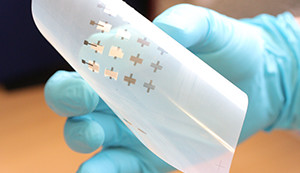Printed two-dimensional transistors
on

Researchers from AMBER (Advanced Materials and BioEngineering Research) and Trinity College (Dublin), together with the TU Delft have succeeded in producing printed transistors, which are made solely from two-dimensional nano materials. These materials have characteristics with much promise and, importantly, can also be produced very cheaply. Possible applications for this procedure are food packaging with a digital countdown timer for the use-by date, wine labels which will show when the contents is at the optimal drinking temperature, security for bank notes and perhaps even flexible solar cells.
The researchers, under the leadership of professors Jonathan Coleman and Georg Duesberg, have used standard printing techniques to combine nano sheets of graphene, which are used as electrodes, with two other nano materials (tungsten diselenide and boron nitride) that function as channel and separator. The result is functional transistor made from nano sheets using only printing technology.
Two-dimensional transistors, as such, are not new – they have already been manufactured using a chemical deposition from the vapor phase. A significant disadvantage of this and other existing methods is their high cost. In comparison, printed electronics is based around printable molecules formed from carbon compounds, which can easily and cheaply be turned into a usable ink.
The material of the printed electronics comprises a large number of nano sheets of different sizes (which are sometimes also called 'flakes'). During the printing process these are layered in a random pattern. The consequence of this is that the printed material is somewhat unstable and the performance has some limitations.
The transistors printed this way are a first important step towards printed 2D-structures made from a single nano sheet. This would dramatically improve the performance of printed electronics. This is the subject of current research at the TU Delft.
Jonathan Coleman from Trinity College is a partner of Graphene flagship, an EU initiative that in the next 10 years has to stimulate new technologies and innovation.


Discussion (1 comment)